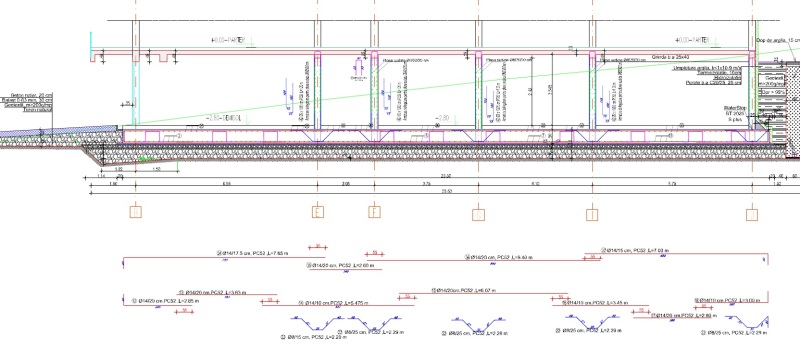Hello to all,
Finally, after a while when i was only reading, now i joined the forum and start asking. I have a dilemma with a project that our company is subjected to do. It is about a 5 stories flat building, with a bearing pressure of about 100 kPa. Because of the low bearing capacity of founding soil, and low deformation modulus we went for a raft foundation. The foundation and superstructure system is the following:
- Raft with a thickness of 50 cm (L x B = 23.5 m x 13.5 m), laying on a bed of crush stone which is about 85 cm thick
- The superstructure - basement with reinforced concrete walls 25 cm thick
- 4 stories with brick load-bearing walls.
- average load transmitted by bearing walls is 100 kN/m
- The construction will be done on a hill, so the basement if actually a semi-basement. Considering this, in the back of the building, where there was excavated of about 6 m of soil, the settlement in theory have to be null, because the bearing pressure is less then the initial soil pressure. In front of the building the foundation will be at about 2 m from original ground surface...so there will be a net pressure.
My questions are the following:
1. We tested the crush stone bed and obtained a dynamic modulus of deformation of 40 MPa. Considering this, when the relative stiffness of super structure and foundation is calculated what deformation modulus of foundation soil should be taken into account? Should be done an average modulus of deformation considering the influence zone of raft foundation? But...if the raft will act in fact as a flexible one, the influence zone will be only about 2-3 meters under raft where load-bearing walls are, and not of about 19m if i consider the raft rigid. So the average modulus of deformation can differ a lot.
2. It if the method considering the raft as an inverted floor slab subjected to 100 kPa uniform pressure, where the reinforced concrete walls are the supports safe in this case? And can this method be adopted for both and flexible raft foundation? What can happened if in reality the raft foundation acts as a flexible one and is calculated whit this method?
3. I could not find anywhere an example where a raft with concrete basement walls is designed. Most examples provided in books and literature, are with columns. Could you provide me a book where i can find and example?
4. We calculated the thickness of raft from shear punch criteria. Should this raft be thicker considering above mentions?
5. Considering that in theory in the back of the building the settlements will be small (considering the amount of soil excavated), so there will be small/no differential settlements --> small stresses ---> less reinforcement (only minimal one provided by design code - EC2). Is this theory correct?
I attached a longitudinal section across the raft.

Finally, after a while when i was only reading, now i joined the forum and start asking. I have a dilemma with a project that our company is subjected to do. It is about a 5 stories flat building, with a bearing pressure of about 100 kPa. Because of the low bearing capacity of founding soil, and low deformation modulus we went for a raft foundation. The foundation and superstructure system is the following:
- Raft with a thickness of 50 cm (L x B = 23.5 m x 13.5 m), laying on a bed of crush stone which is about 85 cm thick
- The superstructure - basement with reinforced concrete walls 25 cm thick
- 4 stories with brick load-bearing walls.
- average load transmitted by bearing walls is 100 kN/m
- The construction will be done on a hill, so the basement if actually a semi-basement. Considering this, in the back of the building, where there was excavated of about 6 m of soil, the settlement in theory have to be null, because the bearing pressure is less then the initial soil pressure. In front of the building the foundation will be at about 2 m from original ground surface...so there will be a net pressure.
My questions are the following:
1. We tested the crush stone bed and obtained a dynamic modulus of deformation of 40 MPa. Considering this, when the relative stiffness of super structure and foundation is calculated what deformation modulus of foundation soil should be taken into account? Should be done an average modulus of deformation considering the influence zone of raft foundation? But...if the raft will act in fact as a flexible one, the influence zone will be only about 2-3 meters under raft where load-bearing walls are, and not of about 19m if i consider the raft rigid. So the average modulus of deformation can differ a lot.
2. It if the method considering the raft as an inverted floor slab subjected to 100 kPa uniform pressure, where the reinforced concrete walls are the supports safe in this case? And can this method be adopted for both and flexible raft foundation? What can happened if in reality the raft foundation acts as a flexible one and is calculated whit this method?
3. I could not find anywhere an example where a raft with concrete basement walls is designed. Most examples provided in books and literature, are with columns. Could you provide me a book where i can find and example?
4. We calculated the thickness of raft from shear punch criteria. Should this raft be thicker considering above mentions?
5. Considering that in theory in the back of the building the settlements will be small (considering the amount of soil excavated), so there will be small/no differential settlements --> small stresses ---> less reinforcement (only minimal one provided by design code - EC2). Is this theory correct?
I attached a longitudinal section across the raft.


![[idea] [idea] [idea]](/data/assets/smilies/idea.gif)
![[r2d2] [r2d2] [r2d2]](/data/assets/smilies/r2d2.gif)